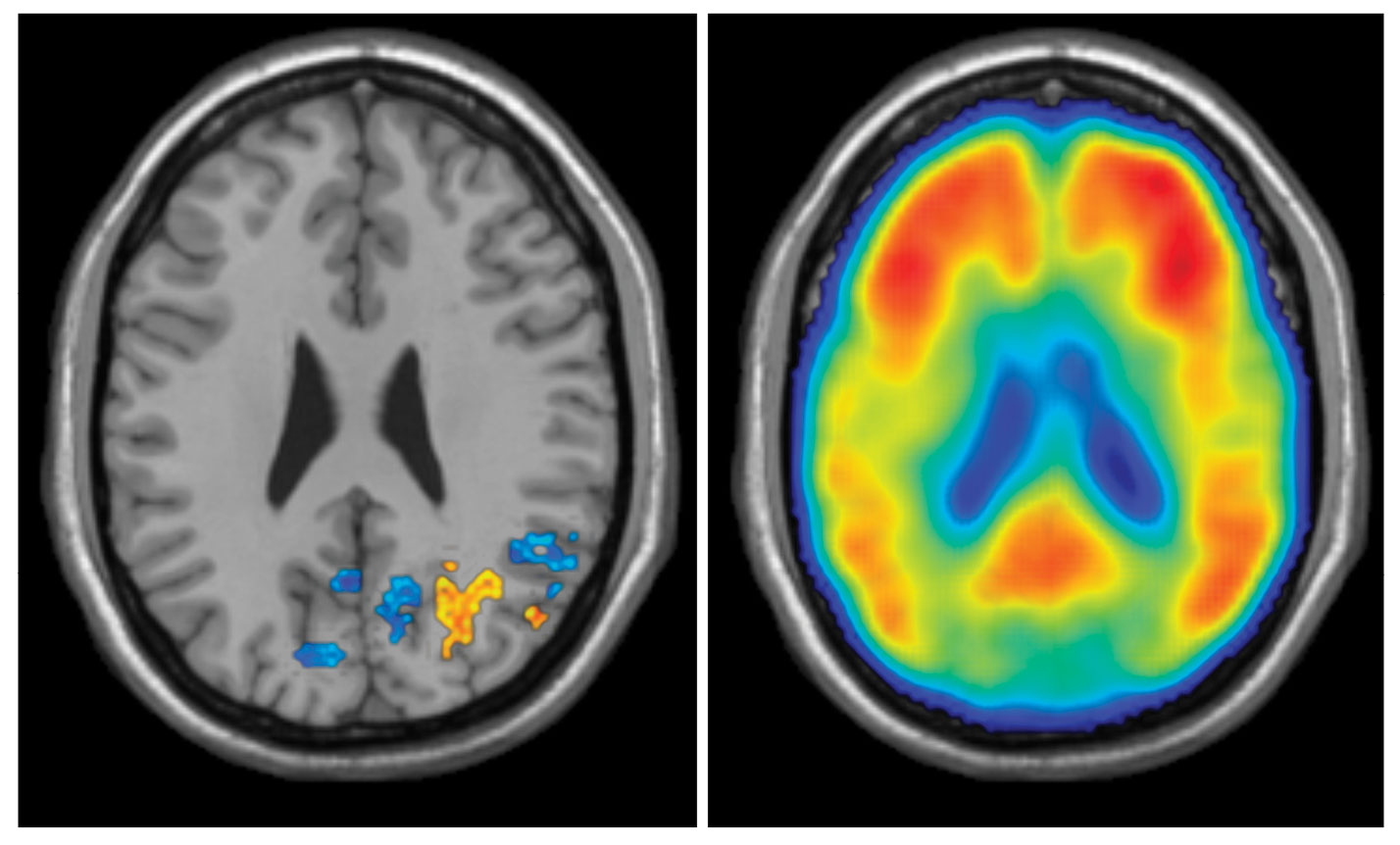 Left: fMRI recordings showed that young people activated orange regions while older people deactivated blue regions during memory formation. Right: PET data showing concentration of amyloid beta (AB) in the brain of older subjects. Regions with high AB (redder colors) correspond to deactivated (blue) regions in the left image. (credit: Jeremy Elman)
Left: fMRI recordings showed that young people activated orange regions while older people deactivated blue regions during memory formation. Right: PET data showing concentration of amyloid beta (AB) in the brain of older subjects. Regions with high AB (redder colors) correspond to deactivated (blue) regions in the left image. (credit: Jeremy Elman)
You can follow Sarah on Twitter @sfhillenbrand
—
Memory loss, the most distinctive symptom of Alzheimer’s disease, breaks hearts and destroys identities. Jeremy Elman has seen it firsthand. Before coming to UC Berkeley for his PhD in psychology, Elman worked with patients at the San Francisco Veteran’s Administration. “Occasionally when we were working with people with severe Alzheimer’s disease, they would become unsure of where they were and who we were,” he says. “Without memory, you constantly awaken in a strange place surrounded by strange people.”
Alzheimer’s disease develops when a protein called amyloid beta (AB) builds up in the brain. AB clumps together to form plaques that interfere with communication between brain cells. Not right away, however; symptoms of Alzheimer’s routinely appear as long as 20 years after AB shows up in the brain. Postmortem studies have shown that about 30 percent of cognitively normal 70-year-olds have AB in their brains. “There’s mounting evidence that AB in a normal person is a sign of trouble to come,” says UC Berkeley Professor of Public Health William Jagust.
How do some people maintain relatively normal cognitive function for years in the face of widespread AB buildup? Elman, Jagust, and Hwamee Oh, a postdoctoral fellow in Jagust’s lab, recently set out to learn the secrets of these resilient brains. The researchers recruited cognitively normal older adults and a group of college students for comparison. Using a recently developed test, they divided the older adults into a group with AB and a group without.
Each participant in the experiment was shown a series of photographs of detailed scenes, such as a boy doing a handstand in front of a red car. As the participants viewed the scenes, the researchers scanned their brains using functional magnetic resonance imaging (fMRI). fMRI detects changes in blood flow in the brain, revealing the location of active brain cells.
After the scan, their memory for these scenes was tested. Importantly, Elman, Oh, and Jagust’s experiment didn’t just classify items as “remembered” or “forgotten.” They also measured the richness of the memories by counting the number of details people successfully remembered. “I always wanted to get a better sense of the complexity of a person’s memory,” says Jagust. “That’s what episodic memory is. It’s a complex set of associations.”
Going over the memories with a fine-tooth comb paid off. The team looked for areas of the brain that were more active when people formed more detailed memories. They found radically different patterns of activation in their three groups. The young brains ramped up activity in a set of areas involved in attention and memory. In contrast, the AB-free older brains turned off the opposing areas, which are associated with mind-wandering. Oddly, when they looked at the AB-laden older brains, they were hyperactive in the same areas used by the young brains.
Elman, Oh, and Jagust’s results suggest that this hyperactivity is a beneficial compensation: greater activation leads to richer recall of details for older adults with AB. Not only did the older adults with AB hyperactivate some areas, they also failed to turn off the opposing mind-wandering areas. The failure of this mechanism likely triggered the compensatory response in the first place.
These brain areas, which their AB-free counterparts had turned off to enhance memory, are often the first to fill up with AB. Therefore, the researchers concluded that once the AB begins to disrupt processing in these areas, the brain switches to inefficient, yet effective, alternative processing strategies. “The brain may have found some way to recruit parts of the brain that wouldn’t normally be used in memory formation to make up for those areas that aren’t performing as well,” says Elman.
Resisting the deleterious effects of AB buildup may be the key to staving off Alzheimer’s disease. Unfortunately, we still don’t know what makes some people more resilient than others. “These people couldn’t tell you what they’re doing when they activate these areas,” says Jagust. “It’s not like riding your bike up a hill. You can’t just tell your brain to pedal harder.”
However, we now know that these people rely upon a compensatory mechanism to maintain normal cognitive function even as AB accumulates in their brains. We also know that people who stay cognitively and physically active have a lower risk of Alzheimer’s. An active lifestyle may be the key to resilience, allowing the brain to encode memories in a new way if the old way begins to fail. Until we know how to stop AB accumulation altogether, understanding where this flexibility comes from may be the next best thing.
This article is part of the Spring 2015 issue.



